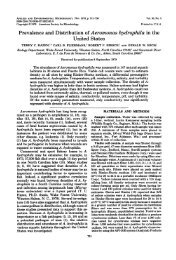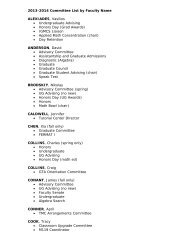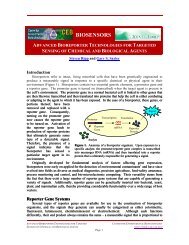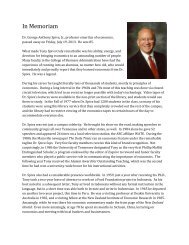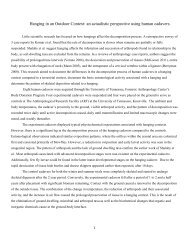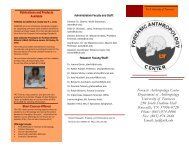Species of Xerula from sub-Saharan Africa
Species of Xerula from sub-Saharan Africa
Species of Xerula from sub-Saharan Africa
You also want an ePaper? Increase the reach of your titles
YUMPU automatically turns print PDFs into web optimized ePapers that Google loves.
Fungal Diversity<br />
Basidiospores are not only <strong>sub</strong>limoniform<br />
but dimpled as well, quite like those <strong>of</strong> X.<br />
megalospora <strong>from</strong> eastern North America.<br />
From SEM images <strong>of</strong> basidiospores <strong>of</strong> X.<br />
megalospora and other species <strong>of</strong> <strong>Xerula</strong>, this<br />
dimpling seems common to the outer wall <strong>of</strong><br />
spores in this generic complex (Petersen,<br />
2007).<br />
The Goossens specimen was accompanied<br />
by a copy <strong>of</strong> outline drawings <strong>of</strong> two<br />
small fruitbodies. The two basidiomata <strong>of</strong> the<br />
Allard specimen are in poor condition, covered<br />
with mold. The characters observed, however,<br />
seem to indicate the four-spored version <strong>of</strong> X.<br />
africana.<br />
In K(M)144257, two basidiomata are<br />
included in a single packet, both collected in<br />
the same place on the same date. Similar in<br />
stature and size, one was noted as white, the<br />
other having no information in this regard and<br />
assumed to have exhibited a brown pileus (as it<br />
is now). Such “albino” forms are relatively<br />
common in some species (i.e. X. megalospora<br />
<strong>from</strong> eastern North America, X. radicata <strong>from</strong><br />
Scandinavia, X. orientalis var. margaritella<br />
<strong>from</strong> Japan). Another specimen (cited under X.<br />
crassibasidiata) was also collected with<br />
identical data, attesting to the variation to be<br />
expected even in a single day’s gatherings.<br />
Specimens examined: DEMOCRATIC<br />
REPUBLIC OF CONGO, Djongo-Akuba, XII.1925, coll<br />
Mme Goossens-Fontana, Goossens no. 508, no.<br />
32228,24 (BR); Vicariat apostolique du Kwano, Région<br />
des Bambata, II.1910, coll RP Allard, leg Hyaç.<br />
Vanderyst (as Collybia radicata), s.n. (BR 032227, 23).<br />
KENYA, Central Prov., Nairobi Dist., Nairobi, City<br />
Park, 10.III.1968, coll DN Pegler (K1; as O. radicata<br />
var. africana), [K(M) 129458]; same location,<br />
12.III.1968, coll DN Pegler (K18, as O. radicata var.<br />
africana), [K(M) 129459]; same location, coll DN<br />
Pegler (K 371; as O. radicata var. africana), [K(M)<br />
129457]; same location, 2.IV.1968, coll DN Pegler (K<br />
372; as O. radicata var. africana), [K(M) 129455];<br />
Nairobi, IV.1986, coll R Gatumbi & W Karia (as O.<br />
radicata var. africana), NAL 3854 [K(M) 144261].<br />
MALAWI, Nyika Nat. Park, surroundings <strong>of</strong> Chelinda<br />
Lodge, 4.XII.1981,leg J Rameloo, no. 7658 (BR; SEM<br />
images 24044-24049); Zomba Mt., 27.XII.1981, coll B<br />
Morris, BM 477B [K(M) 144257]. SOUTH AFRICA,<br />
Natal Prov., Zululand, vic Sibayi, 29.III.1965, coll J<br />
Vahlmeyer (as Oudemansiella radicata), Vahlmeyer 726<br />
(PREM 43114); Cape Prov., Somerset East, Boschberg<br />
Mts., 1845, coll P MacOwan (as Collybia radicata),<br />
MacOwan 1245 (PREM 22041). TANZANIA, Southern<br />
Highlands Region, Iringa District, Mufindi, Lulando<br />
village, Lulando Forest Reserve, lower montane forest,<br />
alt. c. 2000 m, Degree Ref. System Square: 08 35 DA,<br />
15.XII.1990, leg. T. Saarimäki et al., no. 537(H;<br />
holotype). ZAMBIA, Chowo Forest, 14.XII.1981, leg J<br />
Rameloo, no 7899 (BR 032235,31); Manyanjare Forest,<br />
15.XII.1981, leg J. Rameloo, no. 7903 (BR 032236,32).<br />
7A. <strong>Xerula</strong> tetrasperma forma marginata<br />
R.H. Petersen, f. nov.<br />
MycoBank: 511158<br />
Basidiomata ad X. tetrasperma, vel lamellis<br />
marginatis; margine atrobrunneis. Basidiosporis 15.5-21<br />
× 11-16 µm (E m = 1.42; L m = 18.8 µm).<br />
Holotype: ZAMBIA, Chowo Forest,<br />
7.XII.1981, leg J Rameloo, no. 7715 (BR<br />
032232,28).<br />
Basidiomata unusually large for this<br />
species, collybioid, rooting. Pileus 90 mm<br />
diam, shallowly convex with low umbo, dark<br />
brown, smooth, not laccate. Lamellae adnate,<br />
ventricose, white when fresh becoming<br />
ochraceous buff after drying, in three ranks;<br />
margin delicately, abruptly brown-black. Stipe<br />
200 mm to ground line, <strong>of</strong>f-white, minutely<br />
silky and flairing apically, downward sooty<br />
grayish tan, appearing smooth. Spore print <strong>of</strong>fwhite<br />
(2A2).<br />
Pileipellis over pileus margin constructed<br />
<strong>of</strong> a single element; pileocystidia 26-55 × 8-27<br />
µm, pedicellate (usually shortly so), clavate to<br />
sphaeropedunculate, thinwalled, conspicuously<br />
clamped; contents hyaline and homogeneous in<br />
clavate individuals, blotchy deep olive-brown<br />
in sphaeropedunculate individuals. Pleurocystidia<br />
occasional, prominent, 111-184 × 22-30<br />
µm, lecythiform to matchstick-shaped with<br />
somewhat inflated proximal portion, hyaline,<br />
thin-walled, conspicuously clamped; contents<br />
homogeneous below, dull <strong>sub</strong>refringent over<br />
neck, <strong>sub</strong>refringent in capitulum. Basidia 52-<br />
72 × 14-22 µm, clavate <strong>from</strong> pinched base,<br />
four-spored, refringent; contents multiguttulate<br />
when immature, coalescing into several large<br />
guttules filling the basidium by maturity.<br />
Basidiospores 15.5-21 × 11-16 µm (E = 1.27-<br />
1.58; E m = 1.42; L m = 18.8 µm), ovate to<br />
<strong>sub</strong>limoniform, delicately dimpled, hyaline,<br />
refringent: contents opalescent. Lamellar<br />
margin sterile, greatly extending in KOH, a<br />
solid palisade <strong>of</strong> cheilocystidia. Cheilocystidia<br />
36-100 × 9-20 µm, clavate to (occasionally)<br />
broadly fusiform, thin-walled (except rarely in<br />
143





